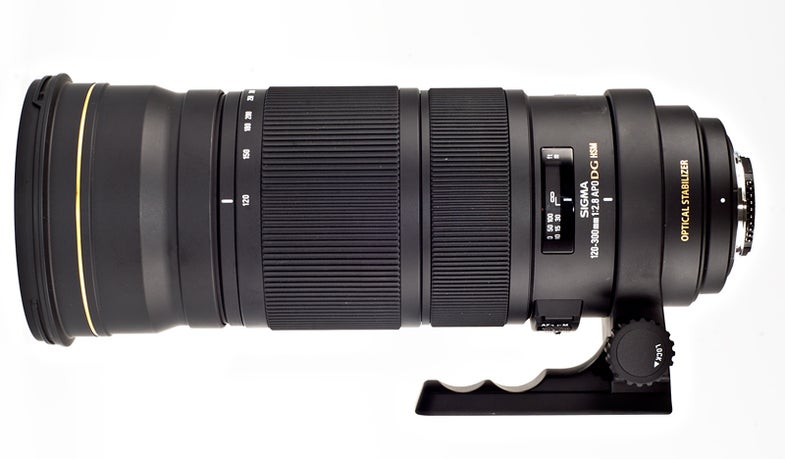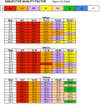Lens Test: Sigma APO 120-300mm f/2.8 EX DG OS HSM
A fast, long lens, now stabilized

We may earn revenue from the products available on this page and participate in affiliate programs. Learn more ›
Sigma has an enviable corner on the f/2.8 long telezoom market: Its massive 200–500mm and more manageable 120–300mm full-framers are the sole occupants of the niche. Now, Sigma has upgraded the latter, adding image stabilization to this pro’s 70–200mm staple on steroids. The tele regions are great for wildlife, while the zoom range and speed will enthrall sports shooters.
If the $3,200 price tag doesn’t clue you in, all those initials in its name should: This is a serious tool. Heavy and large (especially with the 4.25-inch hood attached), the zoom is extremely well built, and, thanks to O-rings and gaskets at each switch and connection, splash-resistant. With three elements of optically pure glass (two FLD and one SLD), it also promises adequate suppression of chromatic aberration.
In the field, we found a monopod a must for this monster, but in a pinch, thanks to its finger-friendly, detachable tripod collar and excellent balance, it was at least temporarily handholdable. Autofocus was responsive, quiet and accurate, though the manual focus and zoom collars, while generously scaled, turned stiffly. Because the outer glass elements are almost flush with the rim, we highly recommend using the oversized hood. Simple to operate, the lens sports only two switches: AF/M and OS.
On our optical bench, the dip from Excellent to Very Good SQF performance at 300mm was expected—it is common in this zoom class. The design has changed significantly since we tested the nonstabilized earlier version of this lens in 2003, and the result is more consistent sharpness and contrast across the aperture range. At 11×14 (our benchmark), the previous lens scored significantly higher SQF numbers at 300mm in the midrange apertures (to 94.4%), but much lower at the smallest (77.9% at f/32). This new lens scores in the mid-to-upper 80th percentile across the board.
Distortion control is now dramatically improved at the three tested focal lengths. Pincushioning dropped to an impressive 0.19% (Slight) at 300mm from 1.08% (Very Visible) with the old lens, for example.
Like the earlier version, this Sigma produces its greatest subject magnification (1:6.7) and tightest focusing distances (approximately 51 inches) at its middle focal lengths—unlike most zooms in this focal range. It required a slight adjustment to our normal approach to close-up subjects: automatically racking out to the longest zoom setting.
While this is obviously an amazing lens, it’s pushing the original 120–300mm f/2.8 out of the Sigma catalogue, which is regrettable. While that less-expensive lens lacked OS, one could argue that image stabilization is superfluous in a lens that’s going to be used mostly on a tripod or monopod.
However, this new lens does give you very improved distortion control. And if its high street price seems hard to swallow, consider it more as two purchases: a 300mm f/2.8 and a high-speed moderate telezoom. Plus, you can push out into the super tele range by using the lens on an APS-sensored DSLR or slapping on a teleconverter. That makes it seem more like three lenses in one.
SPECIFICATIONS
120–300mm (119.98–299.98mm tested), f/2.8 (f/2.93 tested), 23 elements in 18 groups. Focus ring turns 120°. Zoom ring turns 90°. Focal lengths marked at 120-, 150-, 180-, 200-, 250-, and 300mm.
Diagonal view angle: 20–8 degrees.
Weight: 6.61 lb. Filter size: 105mm.
Mounts: Canon AF, Nikon AF, Pentax AF, Sigma AF, Sony/Minolta AF.
Included: Lenshood, case, tripod mount.
Street price: $3,200.
TEST RESULTS
Distortion: At 120mm, 0.07% (Imperceptible) pincushion. At 200mm, 0.14% (Slight) pincushion. At 300mm, 0.19% (Slight) pincushion.
Light falloff: At 120mm, gone by f/3.5. At 200mm, gone by f/3.5. At 300mm, gone by f/3.5.
Close-focusing distance: 50.90–88.93 inches.
Max. magnification ratio: At 120mm, 1:8.80. At 200mm, 1:6.67. At 300mm, 1:8.96.
Image Stabilization: 2–3 stops.
